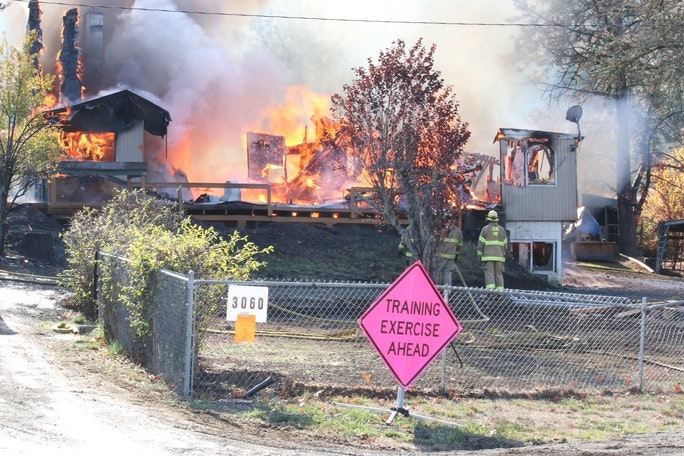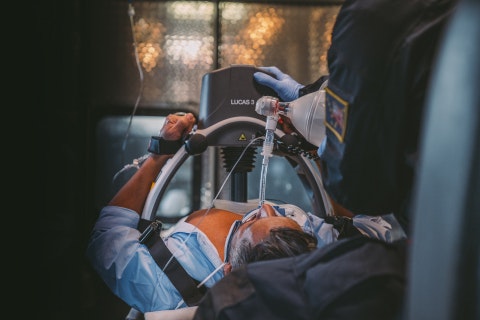Volunteer Training Standards at Lookingglass Rural Fire District

Lookingglass Rural Fire District (LRFD) upholds rigorous training standards for all volunteer members. Our commitment to public safety means we align with the highest national and state guidelines, including those set by:
- Oregon Department of Public Safety Standards and Training (DPSST)
- National Fire Protection Association (NFPA)
- Occupational Safety and Health Administration (OSHA)
- National Wildfire Coordinating Group (NWCG)
- Oregon Health Authority EMS Division
While we are a volunteer fire district, our personnel are trained and certified to the same standards required of career firefighters and emergency medical responders. This commitment ensures that every member is capable, confident, and ready to protect life and property.

Interior Fire Attack and Code Response
Interior Firefighting Staffing Requirements
LRFD follows the OSHA “Two-In, Two-Out” standard (29 CFR 1910.134), which requires:
- A minimum of four firefighters on scene prior to entering a structure fire
- Two firefighters operating inside
- Two standing by outside for immediate rescue if needed
These standards align with:
- NFPA 1720 (Volunteer Departments): Requires at least four personnel on scene for initial attack.
- NFPA 1710 (Career Departments): Recommends 15 personnel on scene within 8 minutes for full response.
Medical Code (Cardiac Arrest) Best Practices
Our EMS personnel are trained to provide high-quality care for cardiac arrest and other medical emergencies, including:
- Clear team roles (compressions, airway, IV access, monitor/defibrillator)
- Communication and leadership during resuscitation efforts
- Adherence to current ACLS/BLS protocols
- Use of Oregon EMS system protocols under the Oregon Health Authority

EMS Certification Training Hours (Oregon Standards)
CertificationHours Required
Emergency Medical Responder (EMR) - 40 to 60 hours
EMT Basic - 120 to 300 hours
Advanced EMT (AEMT) - 100 to 300 additional
EMT Intermediate (Oregon-specific)Varies
Paramedic - 1,500 to 2,500 hours
CPR / First Aid (BLS) - 6 to 8 hours

Fire, Rescue, and Technical Training Hours
CertificationApproximate Hours
NFPA Firefighter 1 - 250 hours
NFPA Firefighter 2 - 100 hours
NFPA Fire Officer 1 - 60 hours
NFPA Fire Officer 2 - 80 hours
NFPA Fire Instructor 1 - 24 hours
NFPA Fire Instructor 2 - 24 hours
NFPA Apparatus Operator / Driver - 32 hours
NFPA Apparatus Operator with Fire Pump - 32 hours
NFPA Mobile Water Supply (Tender Operator) - 32 hours
NFPA Wildland Apparatus Operator - 40 hours
HazMat Awareness - 8 hours
HazMat Operations - 32 hours
Vehicle Extrication – Awareness - 8 hours
Vehicle Extrication – Operations - 24 hours
Vehicle Extrication – Technician - 24 hours
Rope Rescue Awareness - 8 hours
Rope Rescue Operations - 20 hours
Rope Rescue Technician24 hours
NWCG Wildland Firefighter Type 2 (FFT2) - 38 hours
NWCG Wildland Firefighter Type 1 (FFT1) - 40 to 60 hours
NWCG Engine Boss (ENGB) - 40 hours
NWCG Strike Team Leader (STEN) - 40 hours
NWCG Task Force Leader (TFLD) - 40 hours

Annual Continuing Education Requirements
Per OAR 259-009-0062, all Oregon fire service personnel are required to maintain their skills through continuing education:
- Operations Track: 60 hours per year
- Instructor Track: 4 hours per year
- Administrative/Prevention Track: 12 hours per year
- EMS Providers: Must complete ongoing continuing education and skills verification per certification level

The Reality of Volunteer Service
These standards are not just numbers on paper—they represent hundreds and even thousands of hours our volunteers invest to be ready for any emergency. This level of commitment comes with significant sacrifice.
- Weekends spent in training are often the only time off volunteers have with family.
- Nighttime calls often interrupt rest needed for work the following day.
- The demands of training and response are shouldered without compensation.
Despite this, our volunteers continue to serve, train, and respond—because they care about our community.
Why We Require These Standards
- To ensure firefighter and civilian safety
- To maintain compliance with state and federal laws
- To ensure the highest possible quality of emergency service
- To support our mission: Protect life, property, and the environment

Join Us
Lookingglass Rural Fire District provides all training and equipment for those who are willing to serve. Volunteers will receive education that meets or exceeds national standards and the opportunity to be part of a respected, capable, and dedicated team.
For more information, visit the Volunteer or Contact pages or speak to one of our officers.
Lookingglass Rural Fire District
Protecting Our Community Since 1964
